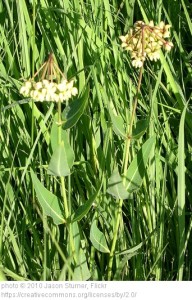In my last post, I talked about some of the challenges facing endangered plant species as crucial elements of the ecosystems they inhabit, such as regular fires or insect pollinators, were lost. This may very well be the tip of the iceberg when you consider that imbalances within ecosystems can also result from too much of something– researchers in Florida found that Liatris ohlingerae, a rare aster, was not negatively impacted by insect herbivory, but white-tailed deer grazing both reduced and delayed flowering, so that fewer seeds were produced (Kettenring et al. 2009). With increasing or overabundant deer populations in many locations of the US, deer may be a real threat to many rare and endangered plant species. Likewise, rabbits on the island of Lampedusa heavily graze a variety of sensitive species there (La Mantia et al. 2012).

Mead’s milkweed (Asclepias meadii) needs different environmental conditions at different life stages.
So how do we keep things in balance for both flora and fauna? Researchers have been working very hard to answer this question, and they are definitely making progress. Some of their results that I find very exciting suggest that low-tech strategies can be really effective. Researchers looking at three endangered seashore plants along the Baltic found that large-scale mowing could be an effective means of maintaining populations for two of the species, while small-scale soil turning could also help two (Rautiainen et al. 2007). La Mantia et al. (2012) were able to restore specific plant populations on Lampedusa through netting to exclude rabbits, focused planting, microbial inoculation, and fences and mats to control erosion.
It’s also important to plan for maintaining gene flow and continuity between generations. Genetic analysis of the fir, Abies cilicica, in Lebanon suggested that corridors need to be maintained between the northern and southern populations to preserve gene flow and offer the opportunity for recolonization by the species (Awad et al. 2014). If populations become too isolated from each other, inbreeding depression could result. Once populations are established, it’s important to think on a multigenerational scale for management- the conditions needed by a young organism may not be the same as those required by an adult of the same species, as with Aslepias meadii Torrey ex. A. Gray, a federally threatened milkweed (Roels 2013), so ensuring that a protected area has a variety of habitats available with different levels and timing of disturbance can be very important.
And researchers are finding creative ways to ensure that endangered plants have the resources they need. Scientists working with the cave-dwelling perennial, Primulina tabacum Hance, in China found that transplanted plants only survived if they were moved to areas with moss, probably because the mosses helped maintained the necessary humidity level (Ren et al. 2010). Targeting areas with moss for plant reintroduction could substantially improve the results of reintroduction plans. Since space is often at a premium and some plants need habitats that are in the process of recovering from some type of disturbance, researchers in the Czech Republic have suggested that the military areas abandoned in Europe since the end of the Cold War could be used to provide habitat for specific plant, bird, and butterfly species (Cizek et al. 2013). Because these areas often provide a mosaic of different habitat types, they have plant and butterfly species richness comparable to or greater than current nature reserves, and are particularly helpful for species needing disturbed or woodland edge habitat. The trick now is to manage such areas so that they don’t all revert back to forest but continue to have a wide variety of habitat types.
So scientists are developing a greater understanding of how to protect and restore endangered plant species, and they are also working to develop early detection strategies so that we can act before the situation gets dire. Some of those efforts involve the public, and might focus around invasive threats to plants, as with the Maui Invasive Species Committee, or try to use botanical gardens like the Alexandru Borza Garden in Romania as nurseries for plants that can be reintroduced. It’s my guess that we all have a part to play in endangered plant conservation- for my next post I’ll look at the options we have for getting directly involved in these efforts.
Works cited:
Awad, L, Fady, B, Khater, C, Roig, A, and R Cheddadi. 2014. Genetic structure and diversity of the endangered fir tree of Lebanon (Abies cilicica Carr.): implications for conservation. PLoS ONE 9: e90086.
Cizek, O, Vrba, P, Benes, J, Hrazsky, Z, Koptik, J, Kucera, T, Marhoul, P, Zamecnik, J, and M Konvicka. 2013. Conservation potential of abandoned military areas matches that of established reserves: plants and butterflies in the Czech Republic. PLoS ONE 8: e53124.
Kettenring, KM, Weekley, CW and ES Menges. 2009. Herbivory delays flowering and reduced fecundity of Liatris ohlingerae (Asteraceae), an endangered, endemic plant of the Florida scrub. Journal of the Torrey Botanical Society 136: 350-362.
La Mantia, T, Messana, G, Billeci, V, Dimarca, A, Del Signore, MB, Leanza, M, Console, SL, Maraventano, G, Nicolini, G, Prazzi, E, Quatrini, P, Sanguedolce, F, Sorrentino, G, and S Pasta. 2012. Combining bioengineering and plant conservation on a Mediterranean islet. iForest 5: 296-305.
Rautiainen, P, Bjornstrom, T, Niemela, M, Arvola, P, Degerman, A, Eravuori, L, Siikamaki, P, Markkola, A, Tuomi, J, and M Hyvarninen. 2007. Management of three endangered plant species in dynamic Baltic seashore meadows. Applied Vegetation Science 10: 25-32.
Ren, H, Ma, Q, Guo, Q, Wang, J, and Z Wang. 2010. Moss is a key nurse plant for reintroduction of the endangered herb, Primulina tabacum Hance. Plant Ecology 209: 313-320.
Roels, SM. 2013. Influence of seed characteristics and site conditions on establishment of the threatened prairie milkweed Asclepias meadii. American Midland Naturalist 170: 370-381.
